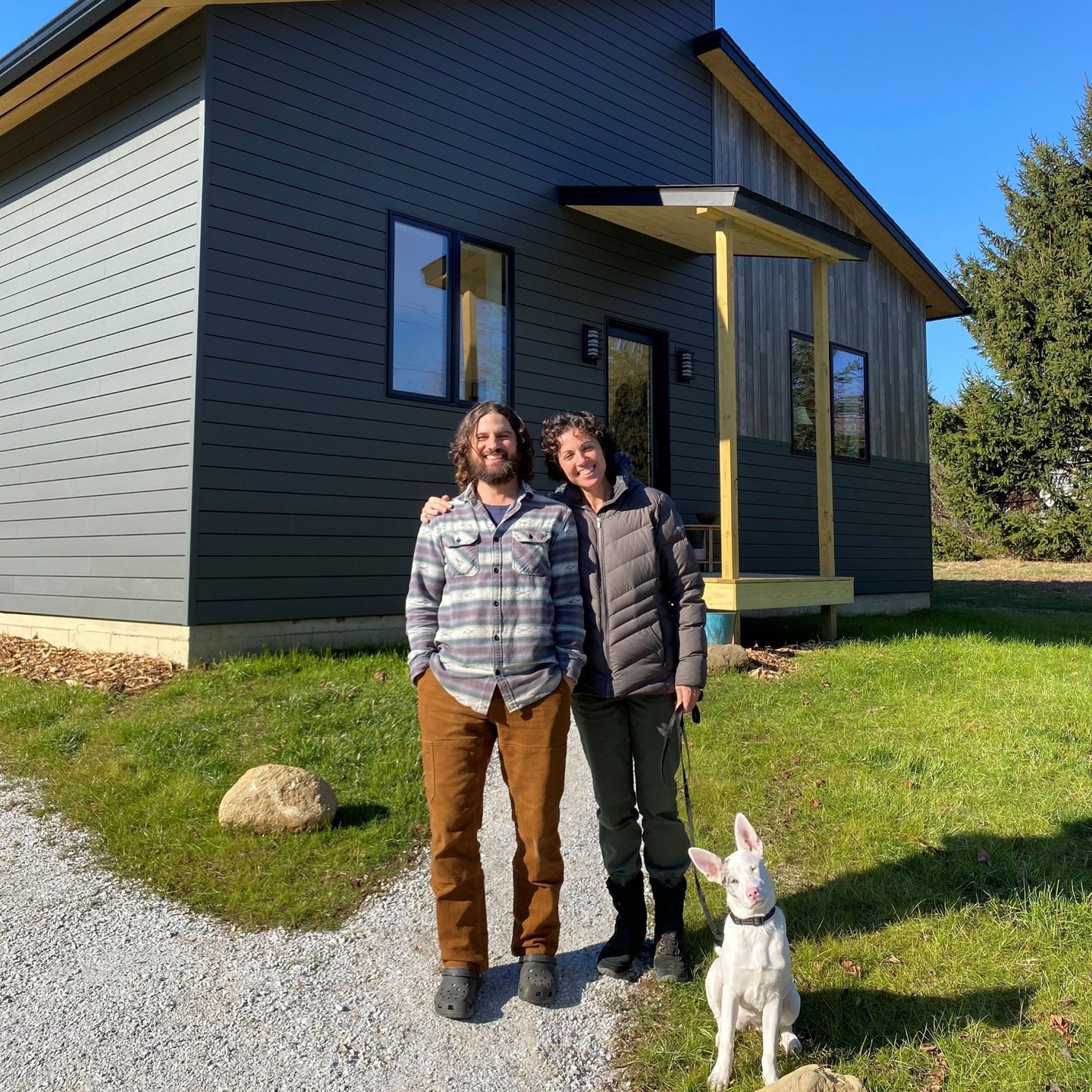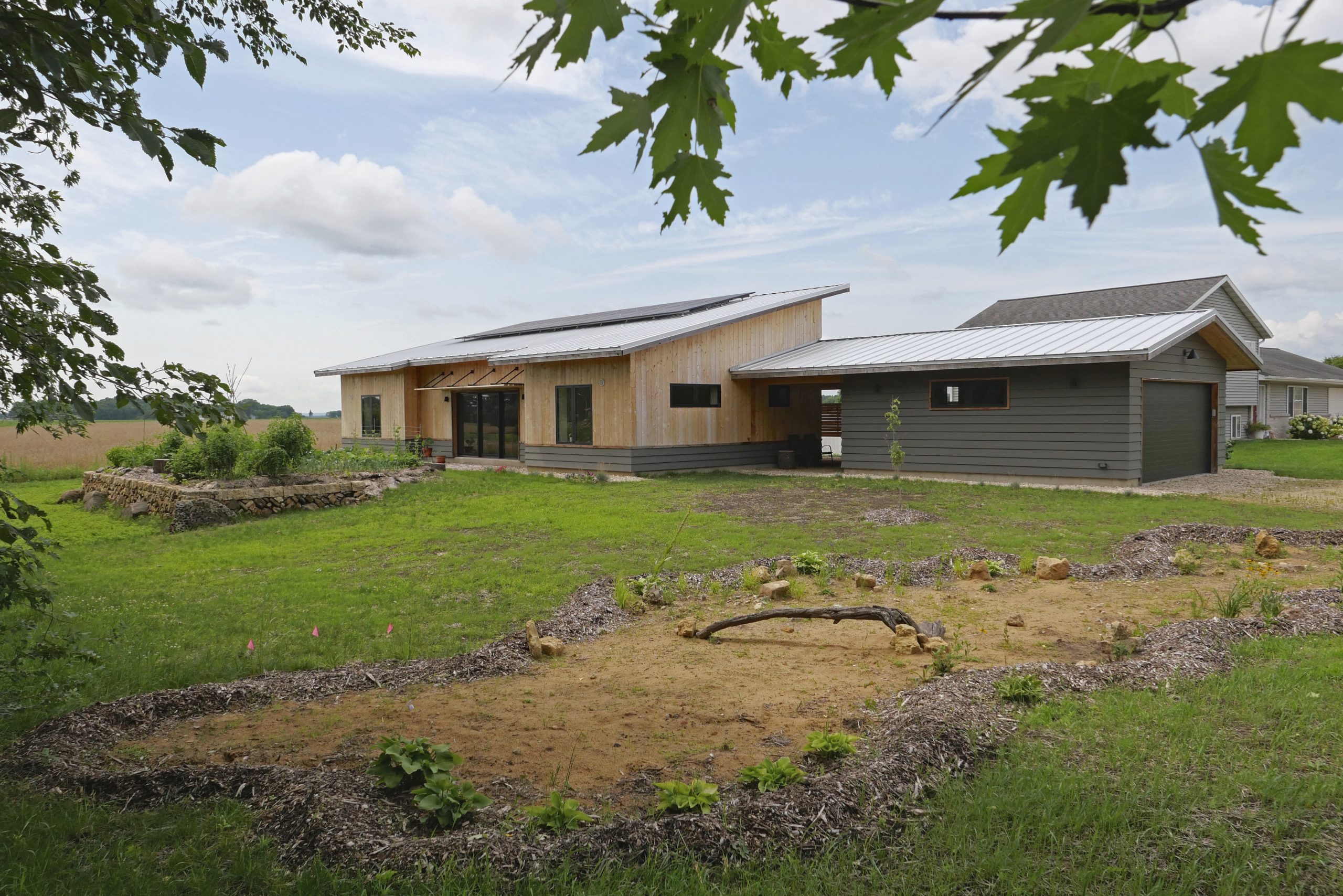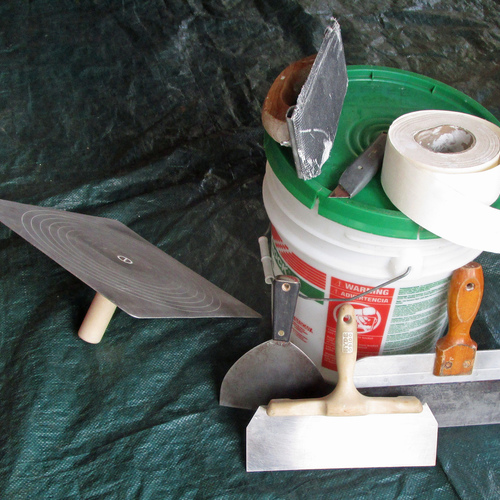
When I tell people that I and my wife, Amy, are building our own home, I often hear in response something like, “Oh yeah, we built our home back in 2004,” or “We’ve built three homes now, isn’t it fun?” What these encouraging folks often mean though, is that they hired someone—maybe a builder; maybe an architect, then a builder—to design and build their house for them. And that can be a significant undertaking. To get the house you want and to make sure you’re building a good home, there’s still tons of research to be done, countless decisions to make, and many big checks to write. They should be proud of their accomplishment. Often, I let the conversation end there.
When I feel the time is right to share, I explain that Amy and I designed our house (well, with a little help) and have been building it full-time since April. We helped with the excavation and septic install, did all of the foundation waterproofing and insulation; we did the framing, installed all of the windows and doors, built the front porch and two decks, and installed all the exterior trim. We’re just wrapping up the siding, and by the end of the month should be moving inside to install doors and flooring, cabinetry and trim, and to tile and paint. We did hire an excavator, a concrete contractor, a plumber (who is also installing our minisplit heat pump), an electrician, a roofer, a dense-pack insulation installer, and we paid to have the drywall done. But we did not have a GC; we hired and managed all of these subs ourselves.
From the many conversations I’ve had over the years working at Fine Homebuilding and here at GBA, I think the term “owner-builder”…
Weekly Newsletter
Get building science and energy efficiency advice, plus special offers, in your inbox.

This article is only available to GBA Prime Members
Sign up for a free trial and get instant access to this article as well as GBA’s complete library of premium articles and construction details.
Start Free TrialAlready a member? Log in















17 Comments
Thank you for writing this, it's great to hear a success (so far) story! My wife and I are planning to owner-build as well, although more subbing out than you have done I think. Our intent is to go ICF, and one of the reasons is that a good number of ICF contractors can get you a house dried-in, including interior framing, and all concrete work. I end up with an airtight R30 building (planning for Amvic R30) without pushing a contractor out of his norm. I know there are downsides to ICF from a CO2 standpoint. From that point, my intent is to focus my labor efforts on anywhere I want something beyond the norm. For example, if I want a ton of extra detail paid toward making the ceiling/attic assembly nearly as airtight as the walls, I need to be out there with tape, membranes, foam, etc.
I believe it's a very challenging process. I imagine it's nice to be more in control of the details though.
I understand that higher performance building is generally more expensive. From what I can find around here though, spec homes are in the $225/sqft range, high performance builders start in the $400/sqft range. It seems high performance builders are only building high end homes. No LVP and laminate countertops go along with R30 walls. I've got a toddler in the house, I don't need anything fancy within his reach!
I was also concerned about pushing contractors to try new things. I know a lot of architects and builders skillfully coach subs along all the time, and that's one of the way different trades learn. I just didn't feel I had the experience (nor the trust of the contractors, perhaps) to be that change agent. Fortunately, I didn't run into the issue much and what we needed to, we did ourselves.
Good luck with your build!
Brian, I’m glad your experience has been good so far, and maybe a lot has to do with the fact you are fairly well educated in our industry and with many resources than most Owner-builders don’t have.
Having said that, I tried to discourage most Owner-builders because there’s a lot of difference between book learning, YouTube or website learning, and jobsite learning. Experience also counts for a big chunk. Probably the most overlooked part of it is Management, as in contracts, scheduling, time management, making sure about codes and regulations, insurances, etc. How many subcontractors and retailers charge extra when they know this is a one-time deal vs. repeat business?
All you have to look is in the Q&A section of the GBA, with questions from Owners, and even Builders, who anyone can tell they are way over their head. Read all the Q&A about insulating attics, basements, HVAC systems, etc…. as if no one knows how to read a code book, let along own and study one.
Once I was asked by an Owner if her house would come with interior doors… when I asked her why she asked me that question, she said that in her previous build, the Builder had charged extra for doors! This is too, a common problem in homebuilding. Shortchanging, cutting corners, substandard practices, and so on.
We all know that in most of the country, Builders are not required to have licenses, minimum education requirements or even code knowledge to do their job, and unfortunately this is opposed by the industry itself and its major advocacies.
Only a handful of clients in 37+ years in the business I can say with ease that they would make a good GC in their own house.
In GENERAL, Owner-builders are a bad idea, and I'm sure my experience is not unique.
You are right about the codes, Armando. Once I got familiar with navigating and reading the IRC, it became an invaluable resource.
Thank you for the comments...
So much truth in this article! Bravo, Brian!
I'm an owner-builder that has spent the past 3 YEARS building a 800 sq ft house (and likely still have most of a year to go), mostly because I insist on doing nearly everything entirely on my own. I have zero experience in all this, though, as my day-job is doing software development.
I learned everything I thought I needed to know from YouTube, books, and websites. There is a staggering amount of info available online.
Still, two major aspects of being an inexperienced owner-builder caught me off guard.
First, there's a massive amount of necessary building knowledge that is NEVER covered anywhere that I've found online. This isn't the "hard" stuff, typically -- it's the stuff that's so basic that the experts don't even consider it something worth sharing. If there are 10 steps total in doing something, the online resources will invariably start at step 5 and it's 1-4 that will absolutely trip me up since it's not going to be obvious to me. That has bit me countless times to date.
Second, building supply companies do NOT want to talk to me or deal with me and most even have requirements of a contractor license to even begin the process. Home Depot and Lowes are by far the most common place I buy my supplies not because their prices or selection is best but rather that they don't blink at selling me what I need. I was able to get some of the critical bits (engineered lumber in particular) by literally calling every single building supply yard in the city and asking if they would sell to me and, indeed, I was able to find two local sources. But yeah, it's like pulling teeth.
The end result is a house that I still have hope will be notably better than 99% of the homes built around me but man, soooooo many mistakes happened (and continue to happen) in the process.
Thanks for sharing Kurt.
I haven't had the same experience with suppliers, thankfully. Perhaps because I'm in a more rural area where the lumberyards are pretty relaxed. Set up an account and you get contractor pricing and service around here.
I do feel you on the gaps in details for a lot of home building work. With all of the magazines, websites, blogs, etc. I still often still struggle to find some basic info that is fundamental to a process.
Brian,
Thanks for the enjoyable read.
"And still, the gaps between knowledge and experience are humbling."
I'm not entirely sure my wife has forgiven me for the experience of building our first house together 35 years ago.
You're welcome Malcolm.
Many people are surprised that Amy and I were willing to do this together, full time. In fact, I was surprised when she agreed to work with me, just because it's not something she ever expressed interest in. Now I often overhear her telling her people about our footing drains and trusses and ERV, which is fun!
Brian,
When you have a moment, stop and think about what you just did. You took undifferentiated space and created a place there. Somewhere that many of the most significant events in your life will occur. That's pure alchemy. A magical process not many people get to experience.
Well said, Malcolm. I love how you put that. I had the pleasure of visiting Brian and Amy when they were working on the foundation. Seeing them down in the muddy trenches, sealing holes by hand in muck boots and hats on a cold day . . . RESPECT. They are the loveliest of people, both individually and together. This house is such a reflection of their thoughtful ways: Simple. Smart. Efficient. Enjoyable. I can't wait to see them inhabit it over time. Undoubtedly, it will be a place of great peace and joy.
I find myself humbled often. I'm not building from scratch but started with an unihabitable ranch house that was stripped to the studs and then alot of the studs needed to be replaced. Might have been easier to do it from scratch.
My only assistance was a local I hired to help me install the windows and heft up the roof sheathing. I also wisely paid someone to put on the standing seam roof to get completely dried in.
I have relied on articles from Building Science but also the resources available here and on FHB. The biggest challenge is deciding on direction and details since I get to be architect, designer, and builder. I am 14 months in working a few days a week.
I am doing this because I wanted to and am deeply interested in how all the pieces come together. What better way to learn than do it yourself.
Having GBA and FHB available has kept me from going from being humbled to being ignorant. Very appreciative for these articles and the experts availabe to answer questions.
Thanks for the read.
ronny2b,
Well done!
Fantastic project! Keep up the good work, Ronny...
I like what you did with the house, I love simple and modern.
I bought a building lot and started building a house in 1982 during a recession.
https://www.greenbuildingadvisor.com/green-homes/a-passive-solar-home-from-the-1980s
Agree with much of what Brian has said. Especially his closing paragraph “this has been [some of] the most rewarding …work in my life…To anyone who has an inclination to build their own house, I say go for it…”
I understand Armando’s objections, but some of us do have enough basic experience, willingness to listen and learn, motivation and work ethic to do as well (or better) than some people in the trades. Owner builders likely care more about the quality of the job they are doing than many subcontractors. Its true that owner builders would work more slowly (and “time is money”), and would need to hire subcontractors to help out or instruct them sometimes. Nothing wrong with that. After all, all those subcontractors didn’t go through a training program and an apprenticeship before showing up at our job sites. Mostly they learned on the job working with someone else, just like owner builders may do.
I’m guessing that Armando works on larger, more complex, cutting edge and high end projects, which an owner-builder is unlikely to attempt. And he likely gets the better subcontractors to work with him. Finally, some of us lack the cash to build, unless we are the primary labor.
Suggestions:
1. If you can, building a house during a recession is much better than building during boom times. Suppliers and subcontractors are more willing and able to help you out, and at lower prices.
2. I worked mostly solo building the house to get the Certificate of Occupancy in a year. Afterwards whenever I hired help, I emphasized workplace safety as our top priority. Working alone, I ended up in the ER three times with minor injuries. After working for a while, you might get the idea that you are Superman or Superwoman and try to lift too much and hurt your back. Table saws have blade guards for a reason. I ducked so the falling roof truss missed me. I avoided falls but be careful. Take the extra time to assure your personal safety and the safety of anyone working with you. I witnessed a roofing contractor laborer fall backwards off a second story roof on the house across the street, suffering internal injuries.
3. Brian already mentioned holding design reviews and getting advice on details from subcontractors. I second and third the motion! I designed for years before developing detailed plans and building a house, and hired a consultant to review the plans. We all can benefit from the knowledge, experience and suggestions of others.
4. Keep it simple! As Brian noted, a rectangular building shell makes A LOT of things much easier to do, and to do well. Design the dimensions to be a multiple of 4’ (or 2’) to reduce material waste and labor, as sheathing is 4’ wide. Stack framing (joists and trusses aligned over studs) on a 24” (or 16”) centers. Try to align doors and windows with the stud framing. Keeping things simple and smaller makes most tasks easier to complete more quickly.
5. As Brian noted, know your strengths, your interests, and your weaknesses. Don’t plan on doing everything, or working without some expert help now and then. Do the work you know and want to do. Sub out work that you don’t want to do, or just can’t do very well. Or hire someone to teach you, as you work together on your project. I hired someone to work with me and teach me foundation work, plumbing, roofing, and tile work. That worked very well. I could do the framing, electrical and insulation myself. Watch YouTube videos and read books and articles if that’s your learning style. Get experience working on other job sites if you can. Like Brian, I subbed out drywall finish work. They work cheaply and fast, and do good work. My drywall finish work sucked, and I wasn’t going to take the time to get better at it, and buy all the drywall tools to do a better job when it cost comparatively little to have someone do that work more quickly.
6. I’d suggest that any new home include a ground floor bathroom that is wheelchair accessible, including roll-in shower at least 3’x5’. It would add at most 50 SQFT to the floor plans, and make the home more usable by handicapped, injured, or elderly residents. Bathroom hopefully located next to a room that could be used as a bedroom, with one of the exterior entrances accessible or easily made accessible later. Make stairways less steep to avoid tumbling falls by children and the elderly. Use door and faucet handles not knobs, and follow other Universal Design guidelines. Most homes cannot made accessible later without far more costly changes.
7. When dealing with building inspectors, shut up and listen. Nod yes. You will be more likely to pass the inspection and get helpful advice. Don’t argue, or you likely fail the inspection, and maybe get hassled later. If you have a subcontractor present, try to get them to avoid arguments with the inspector, as it hurts you more than them.
I quit my job to build the house, and was on a (recklessly) small budget. Consider yourself very lucky if you have the financial resources to avoid the next two suggestions.
8. I bought a building lot with one-third down payment, two-thirds balloon loan with deferred interest due in a couple years. Include a clause in your purchase agreement of a building lot for the seller to agree to subordinate their loan to a construction (or similar) loan. Lenders will expect (or be more agreeable) if they are first in line for repayment, in case your project goes awry. You’ll probably get a better interest rate too.
9. You probably aren’t a general contractor with lots of help and a limited time schedule, so you don’t need to work like them. Consider the minimum you need to do to get a Certificate of Occupancy. After that, you can reside in the house, and refinance your construction loan, or a balloon loan on the building lot. Then or later, you could add appliances and cabinets to the kitchen, put down finish flooring and trim, add a second bathroom to a rough-plumbed empty room, and install nicer fixtures and finishes. If you aren’t sure what is needed to complete to pass the final inspection, I just called for the inspection, and got a list of Must Do items (and skipped the other items). Once you have the Certificate of Occupancy, you can get a job, or go back to work after taking a leave of absence to build a house. Consider adding a garage or a pre-planned addition at a later date to keep the job size more manageable (and cheaper). Hopefully you have a partner working with you who also likes (or at least tolerates) construction work.
If you got to the point of trusses before your first four-letter expletive, that's amazing. Or, should I say, that's &#*$ing amazing.
Okay, maybe that wasn't the first time I let loose, but the first I remember...
Log in or become a member to post a comment.
Sign up Log in